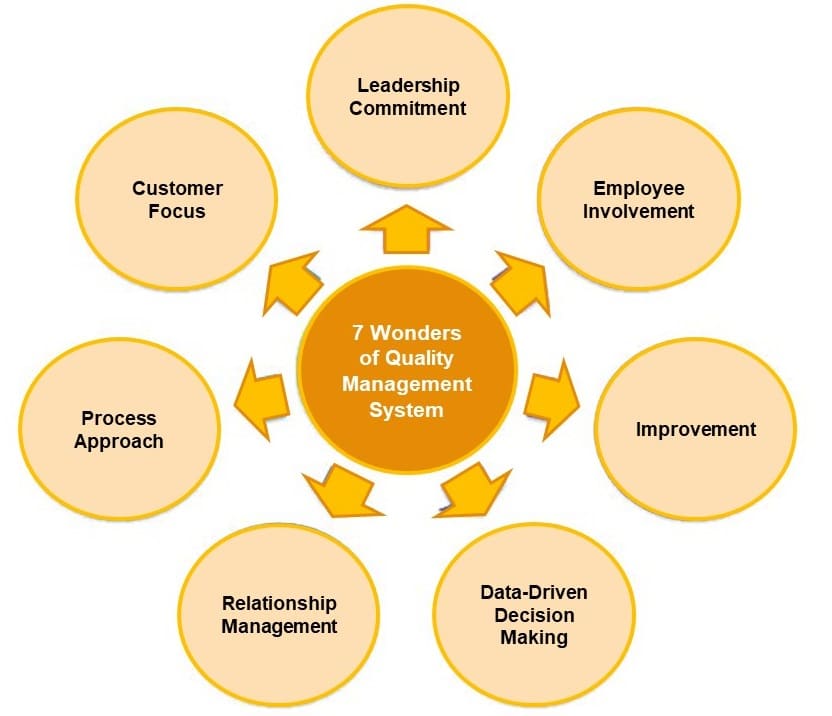The “7 Wonders of Quality Management Systems (QMS)” are not an officially recognized list like the Seven Wonders of the World, but they are seven key elements or principles that are often considered fundamental for a successful 7 Wonders of Quality Management Systems implementation. These principles are essential for organizations looking to improve their quality, enhance customer satisfaction, and achieve operational excellence. Here they are:
Leadership Commitment: Effective 7 Wonders of Quality Management Systems starts at the top. Leadership must demonstrate a strong commitment to quality by setting clear quality objectives, providing resources, and actively participating in quality improvement initiatives. Leaders should also establish a culture of quality throughout the organization.
- Setting a Clear Quality Vision: Leaders must define a clear vision for quality within the organization. This vision should encompass the importance of 7 Wonders of Quality Management Systems in achieving strategic goals.
- Resource Allocation: Commitment also means allocating the necessary resources, including finances, personnel, and technology, to support quality initiatives.
- Leading by Example: Leaders should lead by example, demonstrating their commitment to quality through their actions, decisions, and behaviors.
- Creating a Culture of 7 Wonders of Quality Management Systems: The commitment to quality should permeate the organization’s culture, encouraging all employees to prioritize quality in their work.
Customer Focus: Organizations must understand and prioritize customer needs and expectations. This includes gathering feedback, conducting market research, and aligning product or service offerings with customer requirements. A customer-centric approach is essential for long-term success.
- Understanding Customer Needs: Organizations must actively seek to understand their customers’ needs, preferences, and expectations. This can involve surveys, market research, and direct communication with customers.
- Translating Customer Needs: Once customer needs are understood, organizations must translate them into product or service requirements. This ensures that what is delivered aligns with customer expectations.
- Feedback Mechanisms: Establishing effective feedback mechanisms, such as complaint management systems, can help in continuously monitoring and addressing customer concerns.
- Customer Satisfaction Measurement: Regularly measuring customer satisfaction through surveys or other means allows organizations to gauge how well they are meeting customer expectations.
Process Approach: Viewing the organization as a set of interconnected processes helps identify opportunities for improvement and ensures that processes are designed, controlled, and continually improved. This approach promotes efficiency and consistency.
- Process Identification: Identifying and defining key processes within the organization, such as product development, manufacturing, or customer service.
- Process Mapping: Creating process maps or flowcharts to visualize how processes work and how they interact with one another.
- Process Control: Implementing controls and measures to ensure that processes are consistent and produce 7 Wonders of Quality Management Systems outputs.
- Process Improvement: Continuously seeking opportunities to optimize processes for efficiency and 7 Wonders of Quality Management Systems.
Employee Involvement: Engaging employees at all levels in quality management is crucial. Employees should be empowered to contribute to quality improvement efforts, provide suggestions, and participate in problem-solving. Their knowledge and expertise are valuable assets.
- Empowerment: Empowering employees to take ownership of quality in their respective roles, encouraging them to identify and address quality issues.
- Training and Skill Development: Providing training and development opportunities to ensure that employees have the knowledge and skills needed to contribute effectively to quality improvement efforts.
- Communication: Establishing clear communication channels for employees to share their ideas, suggestions, and concerns related to quality.
- Recognition and Rewards: Recognizing and rewarding employees for their contributions to quality initiatives can motivate them to remain engaged.
Continuous Improvement: The concept of continuous improvement, often associated with methodologies like Lean, Six Sigma, and Kaizen, involves systematically seeking opportunities to enhance processes, products, or services. Organizations should have mechanisms in place for identifying, analyzing, and implementing improvements.
- Plan-Do-Check-Act (PDCA) Cycle: Utilizing the PDCA cycle to systematically identify, plan, implement, and evaluate improvements in processes, products, or services.
- Root Cause Analysis: Conducting thorough root cause analyses to identify the underlying factors contributing to quality issues.
- Quality Tools and Methodologies: Implementing quality improvement tools and methodologies like Lean, Six Sigma, and Total Quality Management (TQM) to guide improvement efforts.
- Benchmarking: Comparing performance metrics with industry benchmarks to identify areas for improvement.
Data-Driven Decision Making: Quality management relies on data and metrics to assess performance and make informed decisions. Organizations should establish methods for collecting, analyzing, and using data to drive improvement efforts and measure the effectiveness of their QMS.
- Data Collection: Establishing data collection processes to capture relevant information about processes, products, and customer feedback.
- Data Analysis: Applying statistical analysis and data interpretation techniques to identify trends, patterns, and areas for improvement.
- Key Performance Indicators (KPIs): Defining and monitoring KPIs that align with quality objectives to assess performance.
- Feedback Loops: Creating feedback loops that allow data-driven insights to inform decision-making processes.
Supplier Relationship Management: Effective supplier management is essential for organizations that rely on external suppliers or partners. This involves selecting reputable suppliers, setting clear quality standards and expectations, monitoring supplier performance, and collaborating for mutual benefit.
- Supplier Selection: Conducting a rigorous selection process to choose suppliers that align with the organization’s quality standards and expectations.
- Supplier Audits: Regularly auditing suppliers to ensure they meet quality requirements and adhere to contractual agreements.
- Collaboration: Establishing collaborative relationships with suppliers to improve communication and address quality issues proactively.
- Risk Assessment: Identifying and assessing potential risks in the supply chain that could impact product or service quality.
Conclusion
These seven principles collectively form the foundation of a robust Quality Management System. When integrated into an organization’s culture and operations, they can lead to improved product or service quality, increased customer satisfaction, and greater competitiveness in the marketplace. Many quality management frameworks and standards, such as ISO 9001, incorporate these principles to guide organizations in implementing effective QMS.

